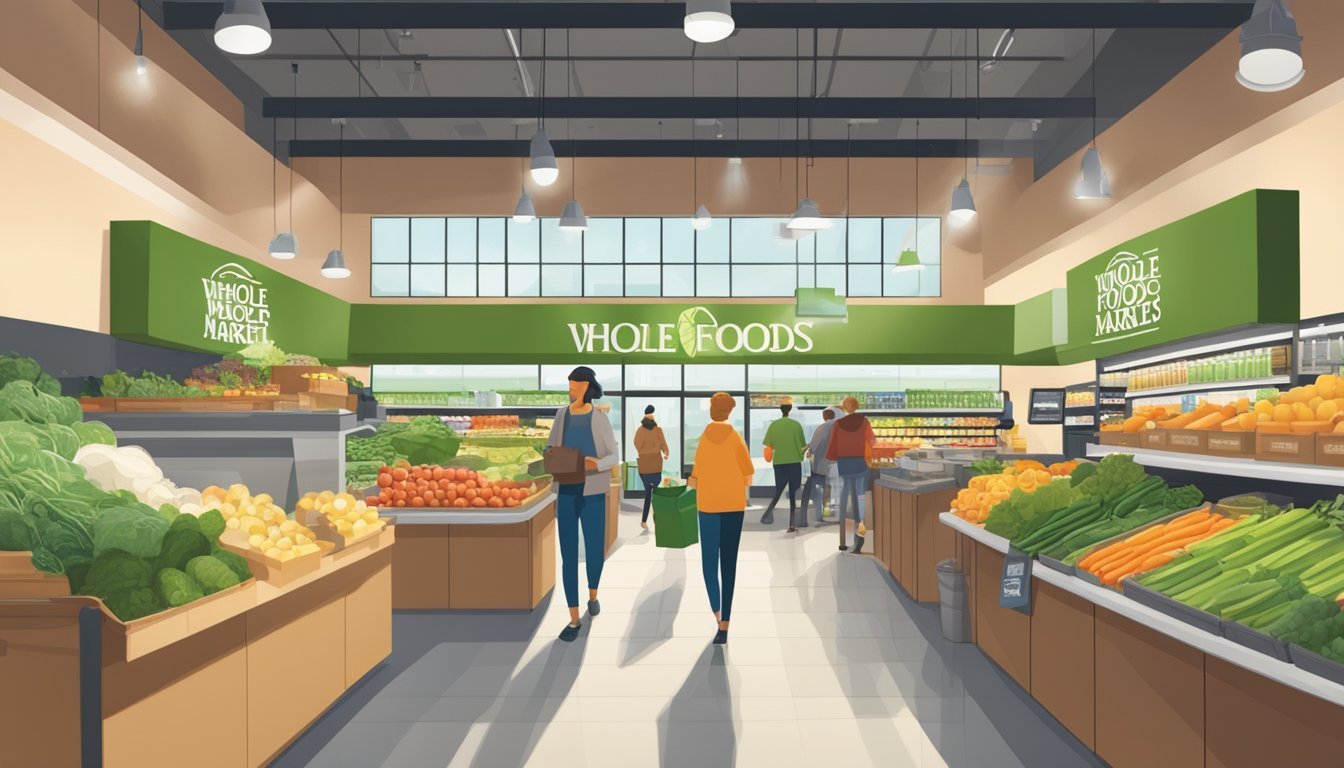Why Whole Foods Market is the Best Grocery Store
Unrivaled Quality and Selection
Whole Foods Market has solidified its position as a top player in the grocery store landscape, distinguishing itself through a staunch commitment to quality and sustainability. Since its inception in 1980, it has grown beyond its Austin, Texas origins to become an international name synonymous with health-conscious living and a broad selection of organic products. This reputation has been further bolstered by Amazon's acquisition in 2017, which merged the convenience of online shopping with the market's diverse offerings.
They cater to a customer base that values not only organic and natural foods but also a transparent and responsible approach to sourcing and environmental impact. Whole Foods Market's popularity is due in part to their community involvement, offering programs such as the "5% days," where a portion of net sales is donated to local non-profits, education, and hospitals, reflecting their commitment to social responsibility.
Shopping at Whole Foods is characterized by an experience that balances selection, quality, and ethical practices. Their expansion under Amazon's umbrella has enhanced the accessibility of healthy food options, integrating modern consumer demands with a proven track record for prioritizing the wellbeing of both people and the planet. This approach positions Whole Foods Market as an appealing destination for those seeking a reliable and conscientious grocery store.
Is Whole Foods Market Cheaper than Other Grocery Store Chains?
Whole Foods Market Compared to Other Grocery Store Chains
Company History and Growth
Whole Foods Market began as a small store and expanded into a leading grocery retailer, noted for its organic options. Its history is marked by strategic growth, culminating in a significant acquisition by Amazon.
Founding of Whole Foods Market
The genesis of Whole Foods Market stretches back to Austin, Texas in 1980, when John Mackey merged his SaferWay store with Clarksville Natural Grocery. This collaboration paved the way for the first Whole Foods location, setting a new standard for grocery stores by offering an extensive selection of natural and organic foods.
Evolution and Expansion
Whole Foods Market initiated its expansion from Austin in 1984, first reaching Houston and Dallas, then acquiring the Whole Food Company in New Orleans in 1988. By 1989, Whole Foods had reached the West Coast, opening a store in Palo Alto, California. The company sustained its growth by continually opening new locations and acquiring other natural food chains. This strategy solidified Whole Foods as a prominent name in the health-conscious consumer market.
Amazon Acquisition
In 2017, Whole Foods Market entered a new chapter when the tech giant Amazon, led by Jeff Bezos, purchased the grocery chain for $13.7 billion. This acquisition brought significant changes to Whole Foods, including technological advances and the expansion of its market reach, yet still maintained Whole Foods' distinct focus on quality organic products.
Quality Standards and Product Selection
Whole Foods Market is renowned for its high bar when it comes to quality standards and a wide range of natural and organic product selections that cater to various dietary needs.
Commitment to Natural and Organic Products
Whole Foods Market is synonymous with organic and natural products, setting it apart from conventional grocery chains. The store is the first and only national grocery store chain to be certified organic, ensuring that from produce to dairy, every organic item has been preserved in its purest form without the interference of GMOs, artificial preservatives, or additives.
Unacceptable Food Ingredients
The store boasts a meticulous ban on over 550 ingredients across their food and beverage selection, including artificial colors, hydrogenated fats, and high-fructose corn syrup. This exclusion is also applied to body care and household cleaning items, demonstrating their commitment to keeping everyday items free from artificial sweeteners and other unacceptable food ingredients.
Specialty Departments and Offerings
A diverse and sophisticated range of specialty departments underscores the uniqueness of Whole Foods Market. With an array of meat, cheese, and seafood that is sustainably sourced and poultry that meets high animal welfare standards, the store caters to various preferences and diets, like vegan and gluten-free. The store also provides organic product choices, extending from organic apples in produce, to organic chicken in their meat department, and more.
Customer Experience
Whole Foods Market prides itself on delivering a superior customer experience characterized by a welcoming in-store atmosphere, a convenient shopping experience, and initiatives that foster community engagement and education.
In-Store Experience
One of the cornerstones of the Whole Foods Market experience is its in-store ambiance. The store's design emphasizes comfortable lighting and a unique layout to create an inviting environment. Prepared food options and a hot bar are abundantly available, catering to those seeking quick, healthy, and delicious meals. The sensory experience is further heightened by the clean and attractive presentation of food items and dedicated spaces for bulk foods reminiscent of a farmers market.
Shopping Experience and Convenience
Whole Foods Market integrates innovative technologies for a seamless shopping experience. The store offers checkout-free transactions and is introducing Amazon One palm payment technology nationwide, significantly speeding up the time it takes for customers to make purchases. Shoppers are encouraged to explore a wide array of high-quality, fresh organic produce, which is a testament to the store's commitment to providing convenience without compromising on quality.
Community and Educational Initiatives
The store is not merely a place to shop but also a community hub where individuals can learn and connect. Educational events related to health, nutrition, and sustainability are a fixture, enriching the shopping experience with valuable knowledge. Moreover, the community feels welcomed to use Whole Foods as a meeting point, fostering a sense of belonging and shared values aligned with health and wellness.
Sustainability and Environmental Practices
Whole Foods Market is recognized for its commitment to sustainability and maintaining rigorous environmental practices within its operations. These integrations range from resource conservation to ethical product sourcing, all in alignment with the company's vision for a healthier planet.
Eco-Friendly Initiatives
Whole Foods Market has implemented a range of eco-friendly initiatives aimed at reducing its environmental impact. The company has been a frontrunner in diverting food waste from landfills, enhancing efforts to make stores more energy efficient, and utilizing greener practices like wind power. Notably, Whole Foods has taken significant measures to eliminate single-use plastic bags, instead encouraging reusable alternatives, and continues to explore and invest in sustainable technologies and resources that contribute to a healthier environment.
Renewable Energy: Utilization of wind power to offset electricity use.
Waste Reduction: Comprehensive recycling and composting programs.
Sustainable Packaging: Initiated the shift towards packaging with reduced environmental impact.
Animal Welfare and Sustainable Sourcing
Animal welfare and sustainable sourcing are at the heart of Whole Foods Market's approach to product selection. The company adheres to the Animal Welfare Standards developed by the Global Animal Partnership to ensure that the animals in its supply chain are treated humanely. This partnership influences sourcing decisions, prioritizing suppliers who demonstrate responsible stewardship of the environment and who uphold strict animal welfare standards. By collaborating closely with these suppliers, Whole Foods maintains its commitment to offering products that are not only high in quality but also align with the FDA's guidelines and ethical practices.
Global Animal Partnership: Partnering with suppliers who meet comprehensive animal welfare standards.
FDA Compliance: Ensuring all products comply with strict regulatory standards for consumer safety.
In summary, Whole Foods Market's sustainability and environmental initiatives demonstrate the company's continuous stride towards a greener and more responsible retail practice, reflecting its leadership in eco-consciousness within the grocery industry.
Innovation and Market Leadership
Whole Foods Market has consistently positioned itself as a leader in the grocery industry through its commitment to innovation and strategic partnerships. Its approach not only meets the current demands of the market but also sets new standards that shape the future of grocery retail.
Strategic Partnerships and Programs
Amazon Prime Integration: Whole Foods Market's acquisition by Amazon has led to significant benefits for Prime members, including exclusive deals and special discounts. The integration allows shoppers to easily sync their Amazon Prime accounts for added convenience and value.
Prime Member Deals: Prime members enjoy weekly discounts on select products.
Delivery and Pickup: Free two-hour delivery on orders over $35 for Prime members in select ZIP codes.
Whole Planet Foundation: Whole Foods Market extends its influence through the Whole Planet Foundation, a nonprofit established to provide microcredit loans in communities around the globe. The foundation supports local entrepreneurs, demonstrating Whole Foods' commitment to economic empowerment and global responsibility.
Innovation in Retail and Online Shopping
E-Commerce Innovation: Whole Foods Market integrates technology with in-store experiences. The company leads the competition by implementing cashierless checkout technology and offering online grocery shopping options, catering to the modern consumer's needs.
Online Ordering: Shoppers can browse and buy groceries online, emphasizing the seamless blend of digital and physical shopping.
Physical Store Experience: Stores feature modern designs and foster a community atmosphere, enhancing the traditional shopping journey and maintaining a competitive edge in the retail space.
Technology Enhancements: Whole Foods Market continually explores and adopts cutting-edge technologies that redefine the grocery shopping experience, ensuring they remain at the forefront of retail innovation.
Price Perception and Value
Whole Foods Market has crafted a distinct image in the world of grocery retail, known for its quality products, which is reflected in its pricing strategies. Customers perceive value in Whole Foods Market not only through prices but also through the quality and range of products offered.
Pricing Policies and Strategies
Whole Foods Market conscientiously sets its pricing policies to balance between offering premium quality and providing value to the customer. The store has implemented competitive pricing on several items under its store brand, 365, which is on par with larger chains. This strategic approach aims to cater to a broader customer base, seeking both upscale and value-for-money products.
Key Points:
365 brand: Competitively priced to match larger chains
Premium products: Priced on perceived quality and sourcing standards
Comparison with Other Grocery Stores
When juxtaposed with other grocery stores like Walmart, Safeway, and Trader Joe’s, Whole Foods Market traditionally holds a reputation for higher prices, a concept known colloquially as "Whole Paycheck." However, recent surveys suggest that Whole Foods Market’s produce is now often less expensive than Kroger's, signaling a shift toward more competitive pricing.
Price Comparisons:
Produce: Up to 7% cheaper than Kroger’s.
Organic Items: Often comparable to other specialized markets.
Store Brand: 365 products priced to compete with mainstream supermarkets.
Historically known for higher prices, Whole Foods Market has engaged in strategic price adjustments, particularly since its acquisition by Amazon, to offer more deals and value to shoppers. This initiative has potentially altered its price perception among consumers, positioning it as a store that balances both price and quality.
Impact on Community and Economy
Whole Foods Market has a significant impact on local and global communities, bolstering economies through a variety of initiatives. These include supporting local producers, providing meals to those in need, and implementing educational programs.
Local and Global Impact
Whole Foods Market sources products from numerous local suppliers, contributing to the prosperity of community economies in different regions, including North America, the United Kingdom, and Canada. By doing so, it not only supports local farmers and businesses but also reduces the carbon footprint associated with long-distance transportation of goods. In urban areas like New York City, particularly in Tribeca, Whole Foods Market often becomes a staple business, attracting other businesses and contributing to the economic vitality of the neighborhood.
Charitable Initiatives and Community Support
Whole Foods Market's commitment to community support is evident through its various charitable initiatives. On 5% Days, the company donates five percent of the day's net sales to local nonprofits and educational organizations, directly benefiting communities in areas where their stores are located. In addition to addressing food security by donating meals—almost 30 million in 2021—the company is involved in global and local education programs, fostering community knowledge and self-reliance. This demonstrates a clear dedication not just to business growth but also to the social and economic development of the places they serve.
Challenges and Controversies
In assessing the performance of Whole Foods Market, it's critical to examine the hurdles and disputes the company faces, including strong competition in the grocery sector and various legal and regulatory challenges.
Competition and Market Challenges
Whole Foods Market faces intense competition from various grocery store chains. A key competitor is Walmart, which has a robust grocery sector leveraging its large economies of scale. Trader Joe's presents another challenge with its cult following and reputation for unique and affordable products. Kroger, with its significant buying power, also competes directly with Whole Foods. When Amazon acquired Whole Foods, it shook up the grocery industry, leading to increased investments in grocery delivery services, where rivals strive to outmatch the innovation brought to the table.
Competitors:
Walmart: Extensive product range, affordability.
Trader Joe's: Unique product selection, customer loyalty.
Kroger: Large economies of scale, competitive pricing.
Legal and Regulatory Issues
Whole Foods Market has also navigated through various legal and regulatory issues. The company settled with the Department of Consumer Affairs after allegations of overcharging. This kind of scrutiny underscores the legal hurdles that the company—if not careful—might face more frequently. Moreover, as a subsidiary of Amazon, Whole Foods is subject to the regulatory environment that comes with being associated with one of the world's largest corporations.
Settlements and Regulations:
Department of Consumer Affairs: Settlement regarding overcharging allegations.
Amazon: Navigates complex regulatory landscapes due to its size and market influence.
Whole Foods Market in Popular Culture
Whole Foods Market has cultivated a distinct presence in popular culture, stemming from its brand image as a premium grocery provider and its interactions with media and public perception.
Brand Perception
Whole Foods, since its inception, has been perceived as a purveyor of natural and organic products, reflecting a commitment to quality and health. This perception has been further bolstered by clever marketing strategies and customer experience, establishing it as "America's Healthiest Grocery Store." The company's presence extends to urban hubs like Manhattan, where it's not just a grocery store but a symbol of a lifestyle. However, it’s often nicknamed "Whole Paycheck," a moniker that comments on the store’s pricing and reflects the public view of Whole Foods as a higher-cost destination for specialty foods.
Media and Public Relations
Whole Foods Market’s media representation has been a mix of praise for its quality and scrutiny for its prices. Media portrayals often highlight its dedication to offering a wide array of organic and environmentally conscious products. However, such portrayals also draw attention to the prices at Whole Foods, with discussions frequently zeroing in on whether the cost matches the value — a fundamental aspect of its "Whole Paycheck" image. Public relations efforts focus on promoting sustainable practices and health-oriented products, which perpetuates its distinctive position in the grocery market. Whole Foods' acquisition by Amazon only intensified media attention, keeping the brand in the limelight and evolving its narrative within popular culture.










